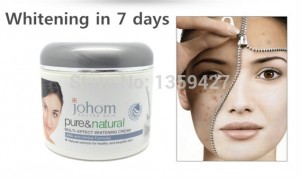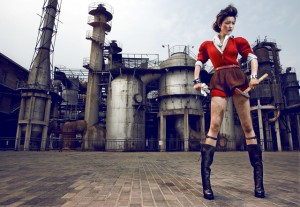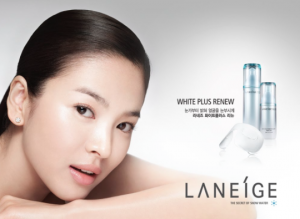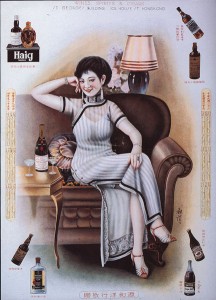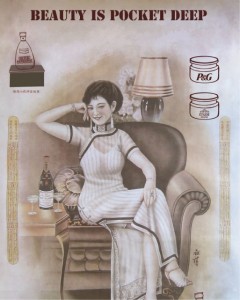In this two-page skin beauty advertisement titled “Skin Genesis (L’Oréal)” in a 2010 U.S Vogue Magazine include two celebrities Eva Longoria and Kerry Washington. They have different skin tones and are photographed for an advertisement for a “complexion equalizer” that is able to provide you with the best looking skin. This advertisement is promoting the beauty of minority women, in this case Latinas and African-Americans; but most importantly the “attainable” beauty “ideal” of a young and flawless looking face which is also an ideal for women in China according to Qinwei (Vivi) Xie and Meng Zhang’s case study.[1]
[1] Xie, Qinwei (Vivi) and Meng Zhang. “White or Tan? A Cross-Cultural Analysis of Skin Beauty Advertisements between China and the United States,” in Asian Journal of Communications 23, no. 5 (Routledge: 2013) 546-547
In this first page of the advertisement the “natural” beauty of these two women consists of having a flawless and non-white skin tone. The viewer can see that they do not have any acne or anything other mark that could ruin the flawless looking skin. Authors of the case study, “White or Tan? A Cross-Cultural Analysis of Skin Beauty Advertisements between China and the United States,” Qinwei (Vivi) Xie and Meng Zhang conclude that advertisements represent the “ideal” appearance of the skin within a country.[1] Having a non-white skin tone was not always desirable in the U.S, but it was not desirable in China. In the 1920s Coco Chanel reproduced tan skin as a trend, so skin beauty advertisements marketed to women in the U.S till this day have women with non-white skin tones.[2] Although in this advertisement both women do not have tan skin, it could symbolize the fact that some Latina and African-American women do not need to be tan because their skin color is naturally non-white or pale. Lastly, the statement at the bottom suggests that having non-white and flawless looking skin is the perfect combination. This advertisement could possibly been one of the advertisements that was used in the case study because it is within the time frame the authors studied which is why I chose it.
the visual advertisement well delivers its message of ideal appearance with non-white skin. Do explain why the non-white as model for the potential Chinese consumers? Any social, gender, ethnic indications?
[1] Xie, Qinwei (Vivi) and Meng Zhang. “White or Tan?,” in Asian Journal of Communications 23, no. 5 (Routledge: 2013) 541
[2] Xie, Qinwei (Vivi) and Meng Zhang. “White or Tan?,” in Asian Journal of Communications 23, no. 5 (Routledge: 2013) 538-539.
On this second page of the the advertisement it does not only show the actual product in a spotlight, but the words and statements used assure young and flawless skin. The advertisement includes statistics in the shape of a graph to show that the process is trustworthy, but also simple. Also states things like “4 weeks to your ideal skin” and the slogan especially “because you’re worth it.” Not only does this advertisement advertise unrealistic expectations for a woman’s skin to look like naturally, but it also makes beauty equivalent to a woman’s worth. Having flawless skin is an easy way for society to value women because it is just based on appearances.
denotation of text and connotation of its message: how does the ad convey its message? let the questions of how the ad draw viewers’ attention and why lead your analysis rather than description. For instance, why minority/colored women as models and why the textual messages?



